Omega-3 fatty acids for intermittent claudication
- PMID: 39470212
- PMCID: PMC11520511
- DOI: 10.1002/14651858.CD003833.pub5
Omega-3 fatty acids for intermittent claudication
Abstract
Background: Peripheral artery disease (PAD) is a progressive disorder characterised by stenosis or occlusion of arteries, or both, due to arteriosclerosis. Intermittent claudication (IC) and diminished walking ability are often present as the main symptoms of PAD. Omega-3 fatty acids have been used in the treatment and prevention of coronary artery disease, although current evidence suggests they may be of limited benefit. Peripheral arterial disease and coronary artery disease share a similar pathogenesis. It is uncertain whether omega-3 fatty acids benefit people with IC. This is an update of the review first published in 2004 and updated in 2013.
Objectives: To evaluate the benefits and harms of omega-3 fatty acid supplementation in people with intermittent claudication.
Search methods: We used standard, extensive Cochrane search methods, and searched the Cochrane Vascular Specialised Register via the Cochrane Register of Studies, CENTRAL, MEDLINE Ovid, Embase Ovid, and two trials registers on 19 April 2024.
Selection criteria: We included randomised controlled trials (RCTs) of omega-3 fatty acids versus placebo or non-omega-3 fatty acids in people with intermittent claudication.
Data collection and analysis: We used standard Cochrane methods. Our primary outcomes were quality of life, pain-free walking distance, and maximal walking distance. Secondary outcomes were ankle-brachial index, revascularisation procedures in the lower limb, amputation rate/frequency, lipid levels, blood pressure, all-cause and vascular mortality, non-fatal vascular events, and adverse effects of therapy. We used GRADE to assess the certainty of the evidence for each outcome.
Main results: We included 15 RCTs (1830 participants) comparing omega-3 fatty acid supplementation with placebo or alternative therapies. The follow-up was four weeks to six years. The majority of the studies had unclear risk of bias, and many could not be included in our meta-analysis, so were reported narratively. The evidence is very uncertain about the effect of omega-3 fatty acids on quality of life. One study measured quality of life but did not present any data. The study authors reported there was no improvement in any of the eight self-reported quality-of-life parameters in the SF-36 questionnaire between entry and 16 weeks for the intervention group. No results were presented for the control group (very low-certainty evidence). Omega-3 fatty acids may result in little to no effect on pain-free walking distance (mean difference (MD) 1.01 metre (m), 95% confidence interval (CI) -34.23 to 36.24; 3 studies, 147 participants; very low-certainty evidence), or maximal walking distance (MD -4.18 m, 95% CI -37.10 to 28.74; 3 studies, 164 participants; very low-certainty evidence). Omega-3 compared with a control may have little to no effect on ankle-brachial index (MD -0.02, 95% CI -0.08 to 0.04; 3 studies, 168 participants; very low-certainty evidence). One study assessed the incidence of revascularisation procedures (lower limb angioplasty/bypass surgery) and rate of amputation (progression of critical limb ischaemia/amputation) in the lower limb. Results showed that omega-3 may have little to no effect on either outcome (very low-certainty evidence). Seven studies reported adverse events. Details of reporting varied amongst studies, and we were unable to combine the results. A total of 47 adverse effects were reported in the intervention groups compared to 33 events in the control groups (7 studies, 488 participants; low-certainty evidence). The evidence suggests that omega-3 results in little to no difference in adverse events. Meta-analyses showed no differences between intervention and placebo groups for cholesterol, triglycerides, or blood pressure. Two studies assessed mortality. All-cause mortality and vascular mortality were reported by one study, and vascular mortality by another. We were unable to pool the studies, but both studies individually reported there were no differences between the omega-3 and the control groups. There was no difference between the intervention and placebo groups for the incidence of non-fatal coronary events (odds ratio (OR) 0.59, 95% CI 0.13 to 2.60; 2 studies, 141 participants), or the incidence of non-fatal stroke/transient ischaemic attack (OR 0.95, 95% CI 0.13 to 6.77; 2 studies, 110 participants).
Authors' conclusions: The evidence is very uncertain about the effect of omega-3 fatty acids in people with intermittent claudication on quality of life, walking distance (pain-free or maximal), ankle-brachial index, and the incidence of revascularisation procedures or frequency of amputation in the lower limb. The evidence suggests that omega-3 results in little to no difference in adverse events. Further high-quality research is needed to fully evaluate short- and long-term effects of omega-3 fatty acids on the most clinically relevant outcomes in people with intermittent claudication.
Copyright © 2024 The Cochrane Collaboration. Published by John Wiley & Sons, Ltd.
Conflict of interest statement
MM: none known TB: none known MR: none known ES: none known. ES has declared that they work as a health professional (Dental clinic) JL: none known
Figures
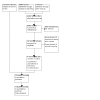
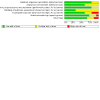



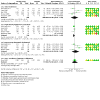

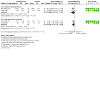
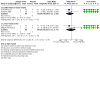
Update of
-
Omega-3 fatty acids for intermittent claudication.Cochrane Database Syst Rev. 2013 Jul 4;(7):CD003833. doi: 10.1002/14651858.CD003833.pub4. Cochrane Database Syst Rev. 2013. Update in: Cochrane Database Syst Rev. 2024 Oct 29;10:CD003833. doi: 10.1002/14651858.CD003833.pub5. PMID: 23824785 Updated.
References
References to studies included in this review
Carrero 2005 {published data only}
-
- Carrero JJ, Lopez-Huertas E, Salmeron LM, Baro L, Ros E. Daily supplementation with (n-3) PUFAs, oleic acid, folic acid, and vitamins B-6 and E increases pain-free walking distance and improves risk factors in men with peripheral vascular disease. Journal of Nutrition 2005;135(6):1393-9. - PubMed
-
- Carrero JJ, Salmerón-Febres LM, Ramos-Gutiérrez VE, López-Huertas E, Ros-Díe E. Study of the clinical and analytical repercussions of a nutritional intervention in non-hospitalised patients with intermittent claudication. A controlled randomised study [Estudio de las repercusiones clínicas y analíticas deuna intervención nutricional en pacientes no hospitalizadoscon claudicación intermitente. Estudio aleatorio controlado]. Angiologia 2006;58(1):19-30.
Carrero 2006 {published data only}
-
- Carrero JJ, Lopez-Huertas E, Salmeron LM, Ramos VE, Baro L, Ros E. Simvastatin and supplementation with omega-3 polyunsaturated fatty acids and vitamins improves claudication distance in a randomized PILOT study in patients with peripheral vascular disease. Nutrition Research (New York, N.Y.) 2006;26(12):637-43.
Conway 2005 {published data only}
-
- Conway K, Dillon M, Evans J, Howells-Jones R, Price P, Harding KG, et al. A double-blinded, randomised study to determine the effect of omega-3-marine triglycerides on intermittent claudication. Yearbook 2005, The Vascular Society of Great Britain & Ireland 2005:Abstract 86.
FLAX‐PAD 2011 {published data only}
-
- Edel AL, Rodriguez-Leyva D, Maddaford TG, Caligiuri SP, Austria JA, Weighell W, et al. Dietary flaxseed independently lowers circulating cholesterol and lowers it beyond the effects of cholesterol-lowering medications alone in patients with peripheral artery disease. Journal of Nutrition 2015;145(4):749-57. - PubMed
-
- Leyva DR, Zahradka P, Ramjiawan B, Guzman R, Aliani M, Pierce GN. The effect of dietary flaxseed on improving symptoms of cardiovascular disease in patients with peripheral artery disease: rationale and design of the FLAX-PAD randomized controlled trial. Contemporary Clinical Trials 2011;32(5):724-30. - PubMed
-
- Rodriguez-Leyva D, Rodriguez-Portelles A, Weighell W, Guzman R, Maddaford TG, Pierce GN. The effects of dietary flaxseed on cardiac arrhythmias and claudication in patients with peripheral arterial disease. Canadian Journal of Physiology and Pharmacology 2018;97(6):557-61. - PubMed
-
- Rodriguez-Leyva D, Weighell W, Edel AL, LaVallee R, Dibrov E, Pinneker R, et al. Potent antihypertensive action of dietary flaxseed in hypertensive patients. Hypertension 2013;62(6):1081-9. - PubMed
Gans 1990 {published data only}
-
- Gans RO, Bilo HJ, Weersink EG, Rauwerda JA, Fonk T, Popp-Snijders C, et al. Fish oil supplementation in patients with stable claudication. American Journal of Surgery 1990;160(5):490-5. - PubMed
Hammer 2019 {published data only}
-
- Hammer A, Moertl D, Schlager O, Matschuck M, Seidinger D, Koppensteiner R, et al. Effects of n-3 PUFA on endothelial function in patients with peripheral arterial disease: a randomised, placebo-controlled, double-blind trial. British Journal of Nutrition 2019;122(6):698-706. - PubMed
Leng 1998 {published data only}
-
- Leng GC, Lee AJ, Fowkes FG, Jepson RG, Horrobin D, Lowe GD, et al. Randomised controlled trial of gamma-linolenic acid and eicosapentaenoic acid in peripheral vascular disease. Prostaglandins, Leukotrienes and Essential Fatty Acids 1997;57(2):Abstract P18.
-
- Leng GC, Lee AJ, Fowkes FG, Jepson RG, Lowe GD, Skinner ER, et al. Randomized controlled trial of gamma-linolenic acid and eicosapentaenoic acid in peripheral arterial disease. Clinical Nutrition (Edinburgh, Scotland) 1998;17(6):265-71. - PubMed
Mackay 2012 {published data only}
-
- Mackay I, Ford I, Thies F, Fielding S, Bachoo P, Brittenden J. Effect of omega-3 fatty acid supplementation on markers of platelet and endothelial function in patients with peripheral arterial disease. Atherosclerosis 2012;221(2):514-20. - PubMed
Mori 1992 {published and unpublished data}
-
- Mori TA, Vandongen R, Mahanian F, Douglas A. Plasma lipid levels and platelet and neutrophil function in patients with vascular disease following fish oil and olive oil supplementation. Metabolism: Clinical and Experimental 1992;41(10):1059-67. - PubMed
OMEGA‐PAD I 2015 {published data only}
-
- Grenon SM, Owens CD, Nosova EV, Hughes‐Fulford M, Alley HF, Chong K, et al. Short-term, high-dose fish oil supplementation increases the production of omega-3 fatty acid-derived mediators in patients with peripheral artery disease (the OMEGA-PAD I trial). Journal of the American Heart Association 2015;4(8):1-14. - PMC - PubMed
OMEGA‐PAD II 2019 {published data only}
-
- Ramirez JL, Gasper WJ, Khetani SA, Zahner GJ, Hills NK, Sansbury BE, et al. Three months of fish oil supplementation increases specialized pro-resolving lipid mediators in patients with peripheral artery disease (The OMEGA-PAD II Trial). Vascular Medicine (London, England) 2018;23(3):306-7.
ORIGIN 2019 {published data only}
-
- Dagenais GR, Jung H, Bogaty P, Bosch J, Yusuf S, Gerstein HC. Effects of basal insulin glargine and omega-3 on lower limb arterial disease outcome in patients with dysglycaemia: ananalysis of the outcome reduction with an initial glargine Intervention (ORIGIN) trial. Diabetes, Obesity & Metabolism 2019;21(6):1502-5. - PubMed
-
- ORIGIN trial investigators. Basal insulin and cardiovascular and other outcomes in dysglycemia. New England Journal of Medicine 2012;367(4):319-28. - PubMed
-
- ORIGIN trial investigators. N-3 fatty acids and cardiovascular outcomes in patients with dysglycemia. New England Journal of Medicine 2012;367(4):309-18. - PubMed
-
- ORIGIN trial investigators. Rationale, design, and baseline characteristics for a large international trial of cardiovascular disease prevention in people with dysglycemia: the ORIGIN Trial (Outcome Reduction with an Initial Glargine Intervention). American Heart Journal 2008;155(1):26-32. - PubMed
Schiano 2008 {published data only}
-
- Schiano V, Laurenzano E, Brevetti G, De Maio JI, Lanero S, Scopacasa, et al. Omega-3 polyunsaturated fatty acid in peripheral arterial disease: effect on lipid pattern, disease severity, inflammation profile, and endothelial function. Clinical Nutrition (Edinburgh, Scotland) 2008;27(2):241-7. - PubMed
Stricker 2008 {published data only}
-
- Stricker H, Duchini F, Facchini M, Mombelli G. Canola oil decreases cholesterol and improves endothelial function in patients with peripheral arterial occlusive disease - a pilot study. Artery Research 2008;2(2):67-73.
References to studies excluded from this review
Berrettini 1996 {published data only}
-
- Berrettini M, Parise P, Ricotta S, Iorio A, Peirone C, Nenci GG. Increased plasma levels of tissue factor pathway inhibitor (TFPI) after n-3 polyunsaturated fatty acids supplementation in patients with chronic atherosclerotic disease. Thrombosis and Haemostasis 1996;75(3):395-400. - PubMed
Caligiuri 2014 {published data only}
-
- Caligiuri SP, Aukema HM, Ravandi A, Guzman R, Dibrov E, Pierce GN. Flaxseed consumption reduces blood pressure in patients with hypertension by altering circulating oxylipins via an a-linolenic acid-induced inhibition of soluble epoxide hydrolase. Hypertension 2014;64(1):53-9. - PubMed
Euctr2013‐004342‐42 {unpublished data only}
-
- Euctr2013-004342-42. The effect of fish oil on red blood cell function and walking distance in patients with arterial occlusion in the legs. clinicaltrialsregister.eu/ctr-search/trial/2013-004342-42/NL (first posted 1 March 2014).
Ishikawa 2010 {published data only}
-
- Ishikawa Y, Yokoyama M, Saito Y, Matsuzaki M, Origasa H, Oikawa S, et al, JELIS Investigators. Preventive effects of eicosapentaenoic acid on coronary artery disease in patients with peripheral arterial disease. Circulation Journal 2010;74(7):1451-7. - PubMed
Madden 2007 {published data only}
-
- Madden J, Brunner A, Dastur ND, Tan RM, Nash GB, Rainger GE, et al. Fish oil induced increase in walking distance, but not ankle brachial pressure index, in peripheral arterial disease is dependent on both body mass index and inflammatory genotype. Prostaglandins, Leukotrienes and Essential Fatty Acids 2007;76(6):331-40. - PubMed
Moller 1998 {published data only}
-
- Moller JM, Hansen AK, Sandermann J, Jelnes R, Jepsen J, Schmidt EB, et al. The effect of n-3 fatty acids in intermittent claudication. European Journal of Clinical Investigation 1998;28(Suppl 1):A28.
Olsson 1984 {published data only}
-
- Olsson AG, Kirstein P, Eklund B, Johnsson H, Walldius G. Ineffectiveness of naudicelle in intermittent claudication. Läkartidningen 1984;81(51):4855-7. - PubMed
Ramirez‐Tortosa 1999 {published data only}
-
- Ramirez-Tortosa C, Lopez-Pedrosa JM, Suarez A, Ros E, Mataix J, Gil A. Olive oil- and fish oil-enriched diets modify plasma lipids and susceptibility of LDL to oxidative modification in free-living male patients with peripheral vascular disease: the Spanish Nutrition Study. British Journal of Nutrition 1999;82(1):31-9. - PubMed
Ruiz‐Canela 2014 {published data only}
-
- Ruiz-Canela M, Estruch R, Corella D, Salas-Salvado J, Martinez-Gonzalez MA. Association of Mediterranean diet with peripheral artery disease: the PREDIMED randomized trial. JAMA 2014;311(4):415-7. - PubMed
References to ongoing studies
Canola‐PAD 2010 {published and unpublished data}
-
- Enns JE, Zahradka P, Guzman RP, Baldwin A, Foot B, Taylor CG. Randomized controlled trial to evaluate the effect of canola oil on blood vessel function in peripheral arterial disease: rationale and design of the Canola-PAD Study. Open Access Journal of Clinical Trials 2014;6:117-25.
-
- Enns JE. Role of Dietary Fatty Acids from Plant-Based Oils in Metabolic and Vascular Disease [Thesis]. Manitoba: College of Medicine, Faculty of Health Sciences, University of Manitoba, 2012.
NCT01256320 {unpublished data only}
-
- NCT01256320. Egg study with peripheral arterial disease. clinicaltrials.gov/ct2/show/NCT01256320 (first posted 8 December 2010).
NCT02096757 {unpublished data only}
-
- NCT02096757. The use of fish oil to reduce inflammation caused by a peripheral vascular intervention. clinicaltrials.gov/ct2/show/NCT02096757 (first posted 26 March 2014).
NCT02152930 {unpublished data only}
-
- NCT02152930. The effects of fish oil supplements during supervised exercise therapy in patients with intermittent claudication (FISHTIC). clinicaltrials.gov/ct2/show/NCT02152930 (first posted 2 June 2014).
UMIN000026607 {unpublished data only}
-
- UMIN000026607. The efficacy of EPA on the clinical outcome in patients with arteriosclerosis obliterans undergoing endovascular treatment: prospective study. https://center6.umin.ac.jp/cgi-open-bin/ctr_e/ctr_view.cgi?recptno=R0000... (first posted 18 March 2017).
Additional references
Abdelhamid 2020
Adili 2019
Barnes 2020
Benjamin 2016
-
- Benjamin IJ, Benjamin I. Andreoli and Carpenter's Cecil Essentials of Medicine. United Kingdom: Elsevier/Saunders, 2016.
Blondeau 2015
Campia 2019
-
- Campia U, Gerhard-Herman M, Piazza G, Goldhaber SZ. Peripheral artery disease: past, present, and future. American Journal of Medicine 2019;132(10):1133-41. - PubMed
Covidence [Computer program]
-
- Covidence. Version accessed 2024. Melbourne, Australia: Veritas Health Innovation, 2024. Available at covidence.org.
Deans Food 2007
-
- Deans Foods Ltd. Columbus healthier eggs. www.columbuseggs.com (accessed 21 August 2007).
Demaison 2002
Enns 2014
-
- Enns J, Yeganeh A, Zarychanski R, Abou-Seta AM, Friesen C, Zarahdka P, et al. The impact of omega-3 polyunsaturated fatty acid supplementation on the incidence of cardiovascular events and complications in peripheral arterial disease: a systematic review and meta-analysis. BMC Cardiovascular Disorders 2014;14:70. - PMC - PubMed
Fish Foundation 2007
-
- The Fish Foundation. Omega-3. www.fish-foundation.org.uk/Omega-3.htm (accessed 21 August 2007).
Fowkes 2017
Frank 2019
-
- Frank U, Nikol S, Belch J, Boc V, Brodmann M, Carpentier PH, et al. ESVM guideline on peripheral arterial disease. VASA. Zeitschrift fur Gefasskrankheiten. Journal for Vascular Diseases 2019;48(102):1-79. - PubMed
Gerhard‐Herman 2017
-
- Gerhard-Herman MD, Gornik HL, Barrett C, Barshes NR, Corriere MA, Drachman DE, et al. 2016 AHA/ACC guideline on the management of patients with lower extremity peripheral artery disease: executive summary: a report of the American College of Cardiology/American Heart Association Task Force on Clinical Practice Guidelines. Circulation 2017;135(12):e686-725. - PMC - PubMed
GRADEpro GDT [Computer program]
-
- GRADEpro GDT. Version accessed 22 April 2024. Hamilton (ON): McMaster University (developed by Evidence Prime), 2024. Available from gradepro.org.
Hamburg 2017
-
- Hamburg NM, Creager MA. Pathophysiology of intermittent claudication in peripheral artery disease. Circulation Journal 2017;81(3):281-9. - PubMed
Hardman 2014
Higgins 2023
-
- Higgins JPT, Thomas J, Chandler J, Cumpston M, Li T, Page MJ, et al, editor(s). Cochrane Handbook for Systematic Reviews of Interventions version 6.4 (updated August 2023). Cochrane, 2023. Available from www.training.cochrane.org/handbook..
Hooper 2018
Innes 2020
Ishihara 2019
-
- Ishihara T, Yoshida M, Arita M. Omega-3 fatty acid-derived mediators that control inflammation and tissue homeostasis. International Immunology 2019;31(9):559-67. - PubMed
Jindeel 2017
-
- Jindeel A. Claudication: a teachable moment or missed opportunity. Clinical Medical Reviews Open Access and Case Reports 2017;4(9):186.
Kinsella 1990
-
- Kinsella JE, Lokesh B, Stone RA. Dietary n-3 polyunsaturated fatty acids and amelioration of cardiovascular disease: possible mechanisms. American Journal of Clinical Nutrition 1990;1(52):1-28. - PubMed
Kirby 2023
-
- Kirby M. Peripheral arterial disease. Diabetes & Primary Care 2023;25(3):1-3.
Lefebvre 2023
-
- Lefebvre C, Glanville J, Briscoe S, Featherstone R, Littlewood A, Marshall C, et al. Chapter 4: Searching for and selecting studies. In: Higgins JPT, Thomas J, Chandler J, Cumpston M, Li T, Page MJ, et al, editor(s). Cochrane Handbook for Systematic Reviews of Interventions Version 6.4 (updated October 2023). Cochrane, 2023. Available from www.training.cochrane.org/handbook.
Mason 2020
McKenzie 2023
-
- McKenzie JE, Brennan SE. Chapter 12: Synthesizing and presenting findings using other methods. In: Higgins JPT, Thomas J, Chandler J, Cumpston M, Li T, Page MJ, et al, editor(s). Cochrane Handbook for Systematic Reviews of Interventions Version 6.4 (updated October 2023). Cochrane, 2023. Available from www.training.cochrane.org/handbook.
Mohammady 2017
-
- Mohammady M, Sadeghi M, Janani L. Intention to treat analysis in randomized clinical trials: a review. Hayat 2017;23(2):138-51.
Mohebi‐Nejad 2014
Mozaffarian 2011
-
- Mozaffarian D, Wu JH. Omega-3 fatty acids and cardiovascular disease effects on risk factors, molecular pathways, and clinical events. Journal of the American College of Cardiology 2011;58(20):2047-67. - PubMed
Omega‐3 2007
-
- Omega-3 Information Service. Omega-3 essential fatty acids. www.clo3.com (accessed 21 August 2007).
Pabon 2022
RevMan 2024 [Computer program]
-
- Review Manager. Version 8.6. The Cochrane Collaboration, 2024. Available at https://revman.cochrane.org.
Roche 2017
-
- Roche Pharmaceuticals. Bridging the nutritional gap: omega-3 LC-PUFA food enrichment. www.foodprocessing.com/Media/MediaManager/Omega3fattyacidsDSM.pdf (accessed 6 June 2013).
Savji 2013
-
- Savji N, Rockman CB, Skolnick AH, Guo Y, Adelman MA, Riles T, et al. Association between advanced age and vascular disease in different arterial territories: a population database of over 3.6 million subjects. Journal of the American College of Cardiology 2013;23(61):1736-43. - PubMed
Schünemann 2020
-
- Schünemann HJ, Mustafa RA, Brozek J, Steingart KR, Leeflang M, Murad MH, et al. GRADE guidelines: 21 part 2. Inconsistency, imprecision, publication bias and other domains for rating the certainty of evidence for test accuracy and presenting it in evidence profiles and summary of findings tables. Journal of Clinical Epidemiology 2020;122:142-52. - PubMed
Seven Seas 2007
-
- Seven Seas Health Care. Pharmaceutical products: Maxepa and Epanoil fish oils. www.sseasirl.com/About/SpecOil/specoil.html (accessed 21 August 2007).
Shu 2018
Song 2019
-
- Song P, Rudan D, Zhu Y, Fowkes FJ, Rahimi K, Fowkes FG, et al. Global, regional, and national prevalence and risk factors for peripheral artery disease in 2015: an updated systematic review and analysis. Lancet Global Health 2019;7(8):e1020-30. - PubMed
Tousoulis 2014
-
- Tousoulis D, Plastiras A, Siasos G, Oikonomou E, Verveniotis A, Kokkou E, et al. Omega-3 PUFAs improved endothelial function and arterial stiffness with a parallel anti-inflammatory effect in adults with metabolic syndrome. Atherosclerosis 2014;232(1):10-6. - PubMed
Wing 2021
-
- Wing EJ, Schiffman FJ. II. Cardiovascular Disease. In: Wing EJ, Schiffman FJ, editors(s). Cecil Essentials of Medicine. 10 edition. Canada: Elsevier Health Sciences, 2021.
References to other published versions of this review
Campbell 2013
Sommerfield 2004
Publication types
MeSH terms
Substances
LinkOut - more resources
Full Text Sources
Medical
Miscellaneous

